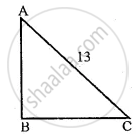Advertisements
Advertisements
प्रश्न
If the sum of two smaller sides of a right – angled triangle is 17cm and the perimeter is 30cm, then find the area of the triangle.
उत्तर
The perimeter of the triangle = 30cm.
Let one of the two small sides = x
then, other side = 17 – x
∴ Length of hypotenuse
= perimeter - sum of other two sides
= 30cm - 17cm
= 13cm.
x2 + (17 - x)2 = (13)2 ...(Pythagoras theorem)
⇒ x2 + 289 + x2 - 34x = 169
⇒ 2x2 - 34x + 289 - 169 = 0
⇒ 2x2 - 34x + 120 = 0
⇒ x2 - 17x + 60 = 0 ...(Dividing by 2)
⇒ x2 - 12x - 5x + 60 = 0
⇒ x(x - 12) - 5(x - 12) = 0
⇒ (x - 12)(x - 5) = 0
Either x - 12 = 0,
then x = 12
or
x - 5 = 0,
then x = 5
(i) when x = 12, then first side = 12cm
and second side = 17 - 12 = 5cm
(ii) When x = 5, then first side = 5
and second side = 17 - 5 = 12
∴ Sides are 5cm. 12cm
Now, area of the triangle
= `(5 xx 12)/(2)`
= `(60)/(2)`
= 30cm2.
APPEARS IN
संबंधित प्रश्न
Solve for x
`(x - 1)/(2x + 1) + (2x + 1)/(x - 1) = 2, "where x" != -1/2, 1`
Three consecutive positive integers are such that the sum of the square of the first and the product of other two is 46, find the integers.
A pole has to be erected at a point on the boundary of a circular park of diameter 13 meters in such a way that the difference of its distances from two diametrically opposite fixed gates A and B on the boundary is 7 meters. Is it the possible to do so? If yes, at what distances from the two gates should the pole be erected?
Solve each of the following equations by factorization:
`x+1/x=2.5`
The sum of the squares to two consecutive positive odd numbers is 514. Find the numbers.
Solve the following quadratic equations by factorization: \[\frac{1}{2a + b + 2x} = \frac{1}{2a} + \frac{1}{b} + \frac{1}{2x}\]
The side (in cm) of a triangle containing the right angle are 5x and 3x – 1. If the area of the triangle is 60 cm². Find the sides of the triangle.
Solve the following quadratic equation by factorisation:
2x2 + ax - a2 = 0 where a ∈ R.
In each of the following, determine whether the given values are solution of the given equation or not:
x2 - 3`sqrt(3)` + 6 = 0; x = `sqrt(3)`, x = -2`sqrt(3)`
Solve the quadratic equation: x2 – 2ax + (a2 – b2) = 0 for x.
